Thermaltake GF2 ARGB (750w) TT Premium Edition PSU Review
Mike Sanders / 3 years ago

For many years, power supplies have generally tended to represent one of the most important yet drabbest (or should that be dullest?) parts of a PC build. Over the last few years, however, Thermaltake has undoubtedly been one of the so-far relatively few companies genuinely looking at changing that perspective. – With the recently launched GF2 ARGB, however, it would appear that things have been kicked into a much higher aesthetic gear now as not only does this look fantastic and better than anything seen before from the company, but as a power supply, it carries some impressive specifications and features that’ll impress even the savviest of consumers!
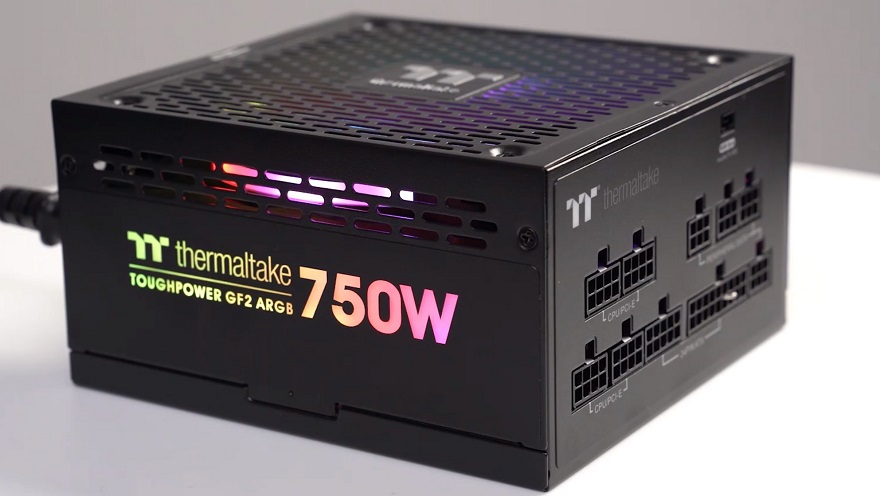
Thermaltake Toughpower GF2 ARGB (750w) Power Supply
In taking their already well-established power supply aesthetics seen in their prior RGB/ARGB product releases, Thermaltake has now decided to expand these illuminating effects to other areas with their logo and product name now part of all that glorious 16.8 million colour action.
As noted above though, while the visuals are impressive, it shouldn’t take anything away from what is undoubtedly a very well equipped power supply with it featuring a fully modular cable design, 80-plus Gold efficiency rating, and “premium” grade Japanese capacitors.

What Does Thermaltake Have to Say?
“Toughpower GF2 ARGB 750W Gold is constructed with premium components and advanced technology which makes this PSU become a reliable and stable power supply unit. The patented 16.8 million-color Riing Duo 140mm RGB fan with 18 LEDs preinstalled helps deliver brighter and richer lighting. The meticulously designed RGB side panels allow the light to glow through from every angle. The Toughpower GF2 ARGB 750W Gold supports synchronization with motherboard RGB software from ASUS, GIGABYTE, MSI, and ASRock for various illumination possibilities. With an ample 10-year warranty, the Toughpower GF2 ARGB 750W Gold is able to satisfy the market, where PC enthusiasts are looking for a premium power supply with all the latest features.”

Features
- 100% High Quality Japanese 105C/221F Capacitors
- High Amperage Single +12V Rail Design
- Industrial Grade Protection Design: Over Voltage, Over Power, Over Current, Over Temperature, and Short Circuit Protection
- Fully Modular Low-Profile Flat Black Cables
- 750W Continuous Output at 40C/104F Operating Environment
- 10-Year Warranty

Specifications
For more detailed specifications, please visit the official product page via the link here!

Connections
Coming as a fully modular power supply, the good news is that you only need to fit the cables you need to power your system’s components. As such, you can ensure the best level of cable management without any ugly redundant connectors cluttering up your case. – Better still though, with Thermaltake offering you more than enough here to hook up even an exceptionally advanced PC system, put simply, you will not find any problems here regardless of which end of the hardware scale your system sits!


Packaging
The Thermaltake GF2 ARGB box work contains everything you would associate with their ToughPower Premium products. The colour scheme is predominantly black and silver with the front giving you a nice clear image of the power supply as well as listing all of its key features.
In terms of initial information at a glance, this design is absolutely spot on!

The rear of the packaging goes into the technical details, specifications, and provides you with more than a few performance charts. The information provided here is excellent, easy on the eye, and will ensure that if you pick this PSU up off a shelf, you will get every single question you could possibly have answered.
Yet again, Thermaltake has proven that in terms of presentation and product particulars, they’re one of the best out there!

Accessories
As this is a power supply, and as you might expect, you neither require nor necessarily want to see a box full of parts when you open its packaging up. Albeit, I live in the horror that someday some manufacturer might decide that a DIY PSU kit might be a good idea! Thankfully, Thermaltake has kept things as simple as possible for you. Aside from the product manual, you are also given a booklet regarding your 10-year warranty, some zip ties to help keep your cabling organized, and, of course, all of the modular cables neatly bundled and ready to go!

In terms of the cabling, as this is a fully modular design, there’s an excellent chance that you won’t need to utilize all of them. To help keep them ready for another day, upgrade, or maybe a new PC build, however, Thermaltake provides you with a nice quality branded canvas bag to ensure that if, as, or when you need them, you know exactly where to look!

A Closer Look
Out of the box, you’ll note that the Thermaltake GF2 ARGB power supply is contained not only within a protective foam covering but within that the PSU itself is also wrapped in a canvas covering. A nice little touch to 100% ensure that this arrives with you in mint condition!

The power supply has a strong and bold aesthetic, even with the lights not yet turned on. Rest assured though, we will be talking about that later, so if you want to know more about the ARGB, keep reading!

While the branding is clear and visible, it’s size and location well suits the overall ethos of the Thermaltake ‘Toughpower’ name. Overall, I suspect that with the lights on or off, you’re going to be immediately hit with the impression that this is a quality design.

The GF2 ARGB is provided with a single cooling fan where a lot (but not all) of the ARGB action occurs. On a more practical level, the fan has a nice central location meaning that the components within should all enjoy a good solid airflow.
Also, with the logo to the centre and all the other branding on this power supply, it looks good, it is well placed, and is of a size that adds rather than detracts to the aesthetics.

With the Thermaltake branding and product naming to the sides, we should note (just in case you haven’t picked up on it yet) that this is also part of the ARGB light show. Thermaltake has also taken the exceptionally wise decision of providing vents immediately above it on either side. While you might initially think that this is merely to do with airflow, we suspect that the key decision for this was to allow even more ARGB to pump from the main fan area.

The power cable input bank is well arranged with each section being itemized to denote what goes where. With a decent amount of room allowed between the ports, both inserting and removing cables is exceptionally easy. You will also note an RGB sync header which will allow this power supplies lighting effects to successfully run in conjunction with other components installed in your PC.

Finally, the rear of the power supply is exceptionally well ventilated with practically the entire space being put to good use. Offering you manual control switches for the RGB lighting and a ‘smart zero fan’ switch, in terms of functionality, you have everything you could want here! Regarding the manual RGB controllers, this is something that would definitely represent a bonus to consumers who don’t yet own ARGB sync compatible motherboards.

Cabling
The cabling you are provided with comes in a sleek black plastic casing that should make it exceptionally easy to feed around your chassis in terms of management. – While the length isn’t overly generous, unless you have a really humongous case design, you shouldn’t have any problems getting everything hooked-up and, more importantly, tidy!
Also, we should also note that similar to the back of the power supply, each cable it itemized to help you quickly identify its usage and where it needs to go.

Internals – A Look Inside!
Once inside the Thermaltake GF2 ARGB, the initial impressions are excellent with all the components and cables appearing to be exceptionally well organized and tidy.

A closer look at the fan confirms this to be a Thermaltake own TT-1425 design which we have seen utilized in a number of their other ARGB equipped products. The fan itself has never failed to impress us in terms of lighting and performance, and as such, it would appear to be an excellent choice for strong visual effects, solid airflow, and quiet acoustic performance thanks to its brushless design.

Regarding the ARGB lighting effects, a closer look at the side panels reveals how Thermaltake has managed to get the branding to be a part of the action thanks to the installation of a panel. I will say that this is the first time I have seen Thermaltake utilize such a design and, as such, are more than curious to see how well this will work.

The power supply’s PCB is exceptionally well arranged with all of the major components well spaced to allow for an excellent level of airflow between them.

A closer look confirms that the two main capacitors utilized within this power supply are Japanese coming from the highly-reputable company, ‘Nichicon’. – With them rated to 105C, these are about as good as it gets and, in terms of a high-quality power supply design, this is definitely more than a little encouraging!
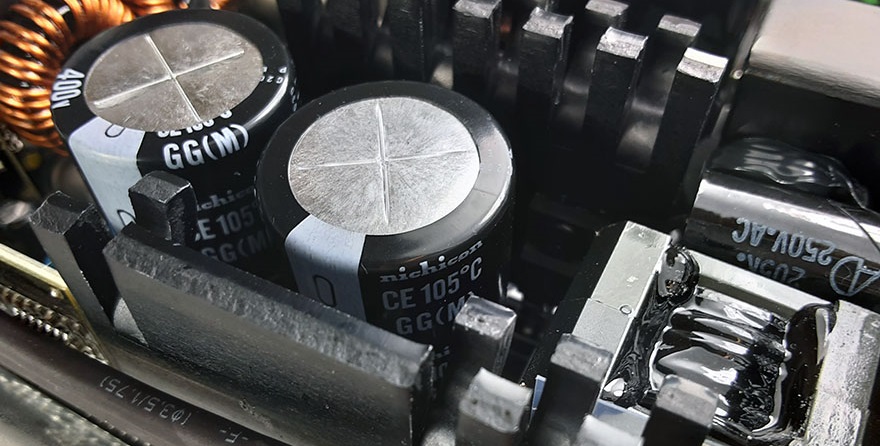
Overall Thoughts!
In terms of its looks, design, and representation, the Thermaltake GF2 ARGB certainly looks to be an exceptionally well put together power supply with a key focus on quality. What about that ARGB lighting though?…

Thermaltake has really taken the light show to a new level here with the fan and side logo providing some surprisingly strong and vibrant effects. With these offering 16.8 million colours and sync compatibility, if you own a chassis design with a tempered glass panel, this PSU would happily join the rest of the ARGB party going on within.
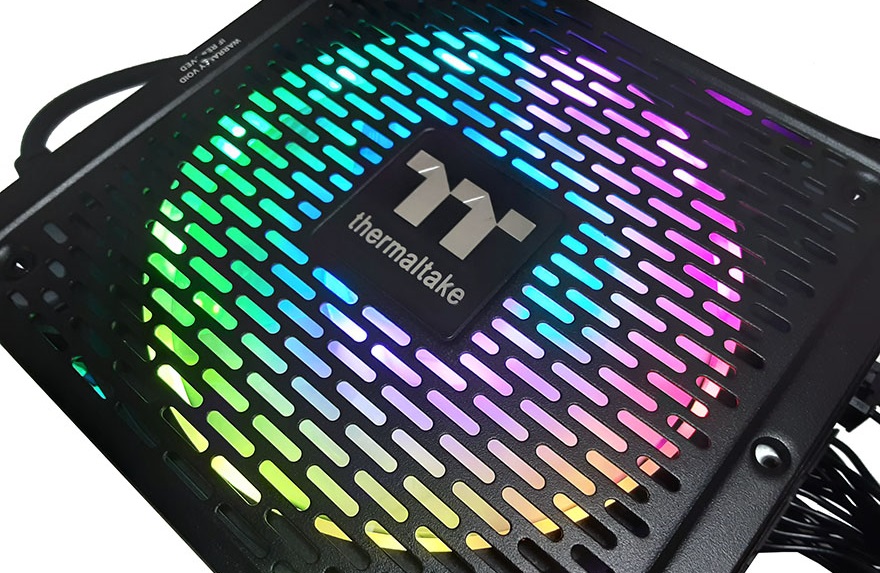
As you can see below, the small vented gaps to the sides of the power supply really allow that fan to blast out that ARGB lighting to its best potential and, overall, in terms of visuals, this may be one of the best looking PSUs I’ve ever seen. – Yes, I know, the jury (as a whole) is still out on RGB for many, but I think it’s hard to deny that this doesn’t look pretty cool!
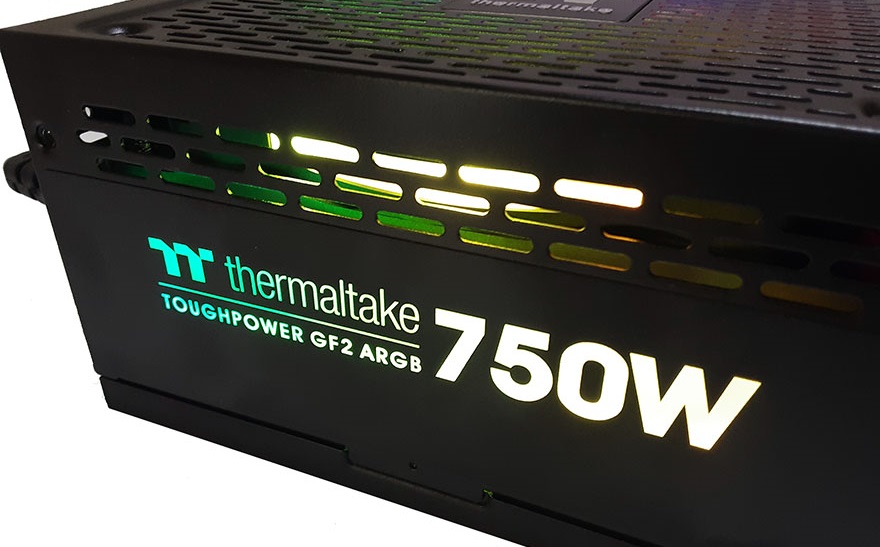
Talking about the ARGB lighting effects is one thing. Giving you some photographs is another. Seeing it in action, however, really gives you the best idea of what you can expect here with the Thermaltake GF2 ARGB and, as such, we have compiled a brief video below showing you them in all their glory!
Methodology & Testing
At eTeknix we take the power supply testing procedure very seriously and have invested a lot of resources into acquiring the appropriate testing equipment. For all power supply reviews, we test the power supplies with dedicated power supply testing equipment. This means we are able to get the most accurate results from our testing as opposed to using software benchmarks (such as OCCT) or multi-meter readouts which are broadly inaccurate.
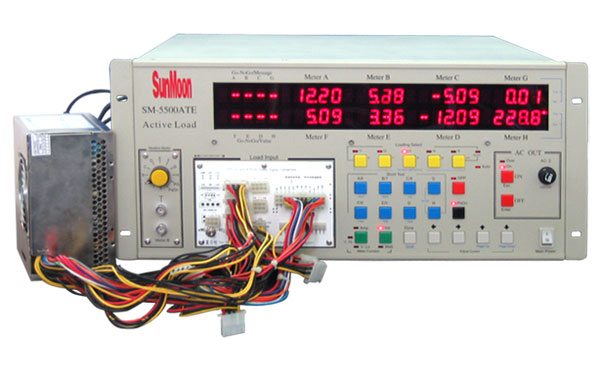
Testing Hardware
- Sunmoon SM-5500ATE Active Load Tester (1200W rated)
- Stingray DS1M12 USB Oscilloscope
- Voltcraft DT-10L laser tachometer
What the eTeknix Test Procedure Involves
- Testing each power supply at 20/40/60/80/100% load (with load balanced across all rails) and measuring PFC (power factor correction), efficiency (actual power divided by power “pulled at the wall”) and voltage regulation (deviance from expected voltages of 3.3/5/12 on the main rails).
- Measuring ripple with an oscilloscope at 20/40/60/80/100% load.
- Measuring fan speed after a stabilisation period of five minutes at each load scenario using the Voltcraft DT-10L laser tachometer and a reflective strip on the fan.
- Testing each power supply’s OPP (Over Power Protection) mechanism and seeing how many watts each power supply can deliver before shutting down
Other Things to Consider
- We recognise that a single 12-volt cable can provide only 6 Amps before overheating (which corrupts voltage regulation and efficiency) and so we used an adequate number of cables for each power supply to ensure there is not efficiency loss from poor cables selection
- Our Sunmoon SM-5500ATE power supply tester is not capable of testing more than 300W on each of the 12-volt rails so where a power supply provides more than 300W on a 12-volt rail that power is distributed over multiple 12-volt rails on the load tester. For example a power supply with one 12 volt rail supplying 750 watts would be spread equally over three 12 volt rails on the load tester, a power supply with two 450W 12v rails would be spread over four 12v rails on the load tester, two 225W 12v rails for each of the 12v rails on the unit.
- We use the same time scale and horizontal millivolt scale on our oscilloscope for all ripple tests, that is a 20ms T/DIV (horizontal) and a 0.02 V/DIV (vertical) meaning the scale is from -80mV to +80mV, ATX spec dictates that the 12v rail must fall within 150mv of ripple and the 3.3/5 within 50mv so that scale allows us to include both 150 and 50mV peaks. (Some older PSU reviews use different scales which were later ditched as the visual representation they give is inadequate, in these reviews written measurements are provided only).
- Deviance is the terminology used to represent the way voltages diverge from the expected values
Voltage Regulation
To test voltage regulation we load the power supply to five different load scenarios that give an equal spread of load across every single rail. So that means 20% on all rails, 40% on all rails and so on. We then calculate the average deviance of each rail from its expected voltage. Ideally, anything of +/- 2% regulation is seen as a very good result.
Power Efficiency
Power efficiency is measured by calculating actual supplied wattage divided by the wattage drawn at the wall/plug, multiplied by 100 to give a percentage. We then compare that to the particular 80 Plus certification the company claims to see if it meets that. You can see the 80 Plus certifications below, we always test power supplies at 230v.
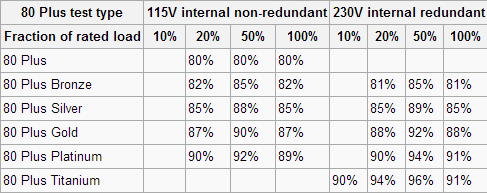
Power Factor Correction
Power Factor Correction is the ratio of the real power flowing to the load, to the apparent power in the circuit. The aim of PFC is to make the load circuitry that is power factor corrected appear purely resistive (apparent power equal to real power). In this case, the voltage and current are in phase and the reactive power consumption is zero. The closer the number to one the better as this allows the most efficient delivery of electrical power (Source – Wikipedia).
Ripple
Noise and Ripple can easily be measured by an oscilloscope. These show how much voltage fluctuation there is on a particular rail. We tested the rail stability of the 3.3-volt, 5-volt and 12-volt rails using an identical time and millivolt scale for all graphs. millivolt ripple is measured by the peak to peak size of the voltage curve.
The latest ATX 12 volt version 2.3 specifications state that ripple from peak to peak must be no higher than 50 millivolts for the 3.3-volt and 5-volt rails, while the 12-volt rail is allowed up to 120 millivolts peak to peak to stay within specifications. Millivolt figures are stated to the closest increment of 5 given their variability.
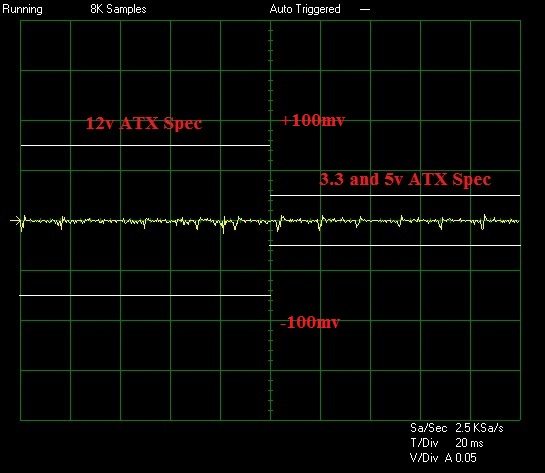
OPP
Power supplies often quote as having various protection mechanisms such and the most important of these is Over Power Protection. In our testing we crank up the power draw until the power supply either shuts down (meaning the OPP mechanism is present and working) or blows up (meaning it is either not present or not working). We then note the maximum power consumption before the power supply shut down, or before it blew up.
Fan Speed
When testing in a power supply laboratory it is difficult to take fan noise readings as the noise from the Sunmoon test equipment and air conditioning corrupts everything. The next best thing in our circumstances was reading off the fan speed with a tachometer to get an idea for the noise. The ambient temperature during testing held constant at 22 degrees, with 1 degree of variation. Each power supply had a consistent time period of 5 minutes to stabilise between each load scenario.
In my experience, the following general relationships apply between noise levels and fan speeds, though it can vary greatly between the type of fan used.
- Below 800 RPM – Inaudible/Silent
- 800 to 1000 RPM – Barely audible
- 1000 – 1200 RPM – Audible but still quiet
- 1200 – 1400 RPM – Moderately noisy
- 1400 – 1800 RPM – Noisy
- 1800 RPM or above – Intolerable
Efficiency
As this is an 80-plus Gold efficiency rated power supply, Thermaltake has clearly set a rather high bar in terms of how much power goes in versus how much comes out to your components. – While the GF2 ARGB doesn’t provide any results significantly beyond above and beyond the required remit, the efficiency scores provided in our test were excellent for the ‘Gold’ standard.
As you can see in the chart below, other than at 100% load, the Thermaltake GF2 ARGB provided consistent efficiency scores of over 91% meaning that, by and large, for an 80-Plus Gold rating, this is definitely towards the higher end of the tier.
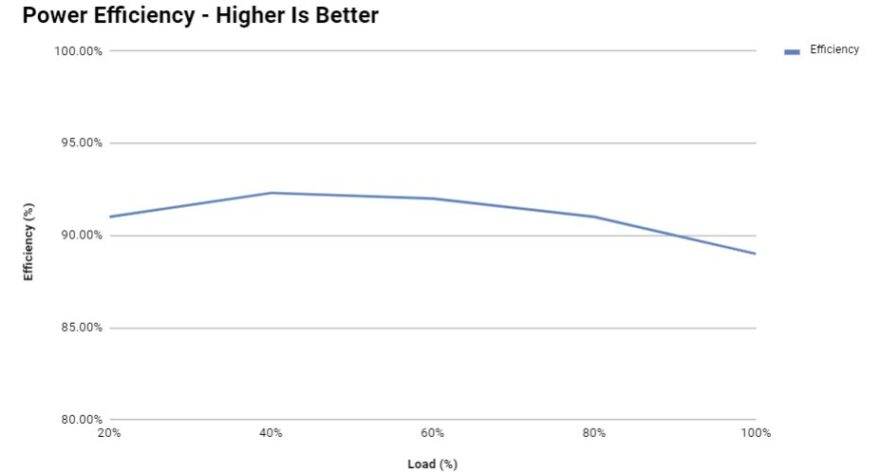
PFC (Power Factor Correction)
When this power supply is put to work, the PFC quickly ramps up to an impressively high level, scoring 0.984 at 100% load. Which, just in case you didn’t know, is a very high rating indeed. In fairness, though, we can’t honestly say that we were overly surprised by this. For the masses of Thermaltake power supplies we have reviewed in the past, they have consistently provided excellent PFC results in our testing and the GF2 ARGB, quite simply, is yet another great example of this!
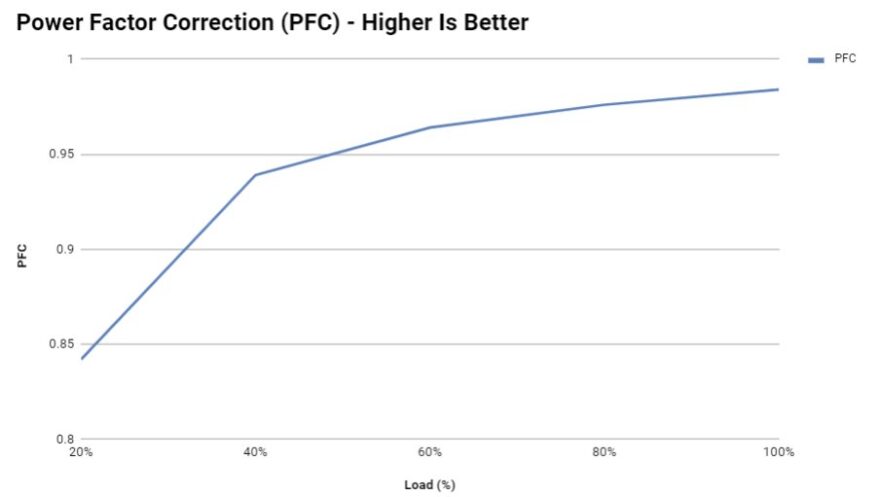
Voltage Regulation
With the exception of the -12V rail (which isn’t overly important in modern PC designs anyway), the results provided in our voltage regulation testing were solid and consistent. A quick look at the overall average deviancy highlights that, regardless of the power output, the GF2 ARGB provides a power delivery that is nearly always (give or take a minimal margin) of the same level.
Are the -12V results bad though? Well, in a nutshell, no. – Based on many other results seen in the past from various manufacturers, this is, quite honestly, about what we expect to see. And again, we should highlight, the importance of this rail has significantly dropped over the last 10-20 years of PC design.

Ripple
With ‘low ripple noise’ cited as one of the main key features of the Thermaltake GF2 ARGB, it hasn’t come as any surprise to find that throughout all of our load testing, the maximum score achieved was only 9. – Just to put this result into context, under EU regulations the maximum allowed is 50 which perhaps best highlights just how amazingly low this result is.
Put simply, if you value clean power delivery in your power supplies, then the GF2 ARGB knocks the ball right out of the park!
| Load (%) | 3.3V Ripple | 5V Ripple | 12V Ripple |
| 20 | 3.2 | 3.4 | 6.8 |
| 40 | 4.2 | 4.2 | 9 |
| 60 | 5.4 | 4.6 | 7.4 |
| 80 | 5.4 | 6.6 | 7.8 |
| 100 | 7 | 9.6 | 8 |
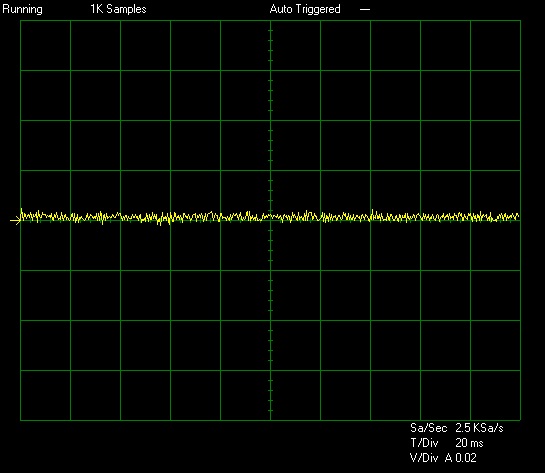
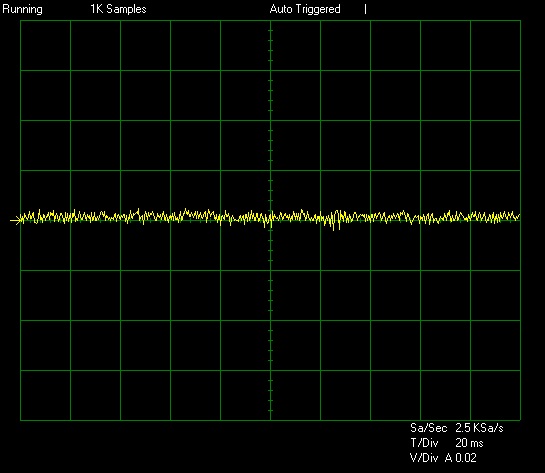
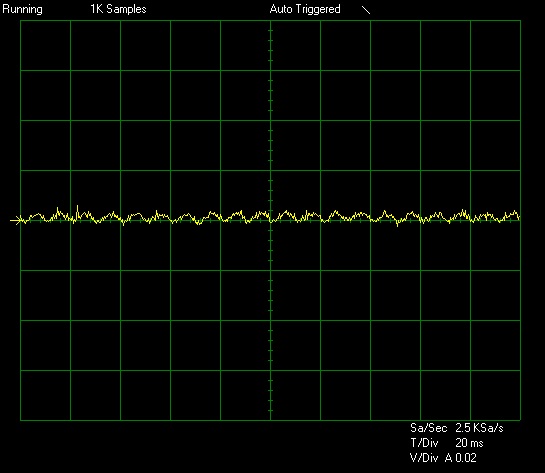
Over Power Protection and Max Wattage
While power supplies are provided with a rated wattage output amount, it is never uncommon for a little wiggle room to be available above that in most designs. If a user does push things beyond that amount, however, which incidentally is never advisable, it is important to know that the PSU will automatically shut itself down before the risk of any damage (to the power supply or your components) can present itself.
Achieving a top wattage of 976, we can confirm that the over power protections worked exactly as they should with the GF2 ARGB, but more so, it’s certainly impressive to see that it was able to achieve around 25% above the rated value before this did kick in.

Fan Speed
In our testing, the Thermaltake GF2 ARGB achieved a maximum fan speed of just under 500 RPM. As such, we can categorically confirm that not only is this notable lower than most alternative designs but in terms of noise output, this is practically silent.
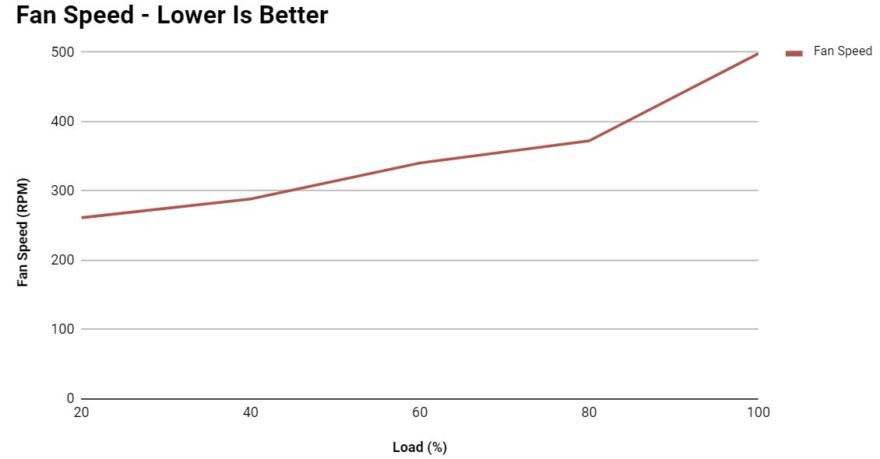
With a hybrid function available, it would appear that, overall, the Thermaltake GF2 ARGB operates on a 3-tier level design. At low outputs, the power supply doesn’t deem it necessary for the fan to run at all. At mid-levels, it operates at around 50% speed (compared to the standard fan mode), and at 100% it generally tends to run at about the same comparative speed.
Given the overall low noise output of the fan in ‘standard’ mode, the inclusion of a ‘hybrid’ function does perhaps seem a little unnecessarily. For those of you who value quiet system performance, however, it’s definitely a great option to consider.
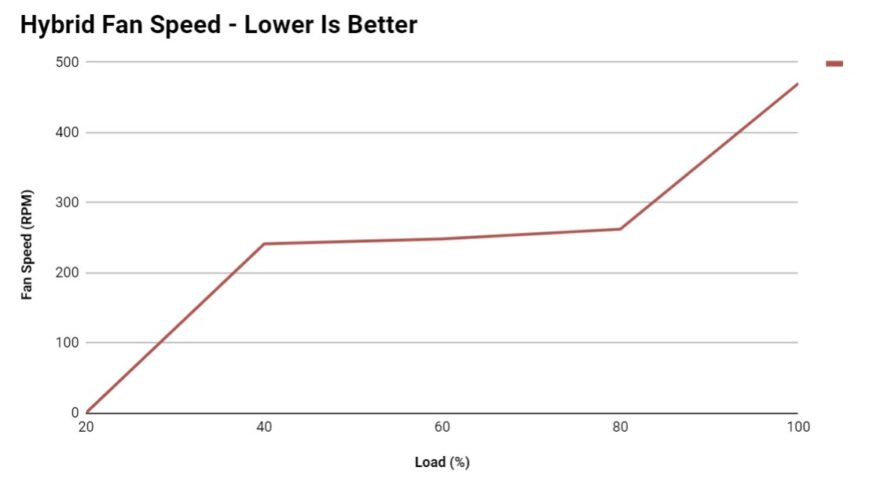
How Much Does it Cost?
With it set to hit retailers in the UK on February 19th, the Thermaltake GF2 ARGB 750w power supply will come with a price tag of around £134.99. So getting one elephant out of the room very quickly, and just in case you needed confirmation of it, this PSU isn’t cheap, and it’s certainly not budgeted or designed as an ‘entry-level’ product.
Comparatively speaking, however, while there are, of course, many power supplies that offer similar levels of performance, at least to my knowledge, none of them carry the aesthetics that the GF2 ARGB does and, quite frankly, I think that the truly unique and vibrant visual appearance does warrant the expense.
Performance
As can be seen throughout our testing, the Thermaltake GF2 ARGB did not fail to impress us as a completely solid and well-designed power supply. Be it efficiency, ripple, fan speed, PFC, or voltage regulation, the results provided speak volumes of a quality product.
Yes, there are a few tiny niggles we could make about an even smaller number of results in certain tests. In all honesty, though, it would only be for the sake of nit-picking. Overall, this PSU is practically faultless!
Practicality & Functionality
With its plethora of impressive features, the Thermaltake GF2 ARGB is definitely a truly top-contender in the power supply market. A high-efficiency rating (that our testing entirely confirmed), a fully modular cable design, Japanese main capacitors (and good ones too). Put simply, these are all the boxes that the savvy PSU consumer should be looking to tick off when choosing their next model, and even if you completely disregard the ARGB lighting effects, which admittedly is hard to ignore, then the GF2 ARGB still remains a fantastic choice!
Should I Buy One?
With increasing numbers of PC owners choosing tempered glass PC cases, having a power supply that can add to the light show and overall presentation is undoubtedly a very tempting proposition. Make no bones about it though, while the ARGB effects are impressive, underneath them still beats the heart of one of the best power supplies Thermaltake has released to date.
The Thermaltake GF2 ARGB TT Premium Edition power supply comes wattage outputs ranging from 650w-850w. Whichever one you pick to suit your needs, you’re going to be very happy with what Thermaltake has offer!




















